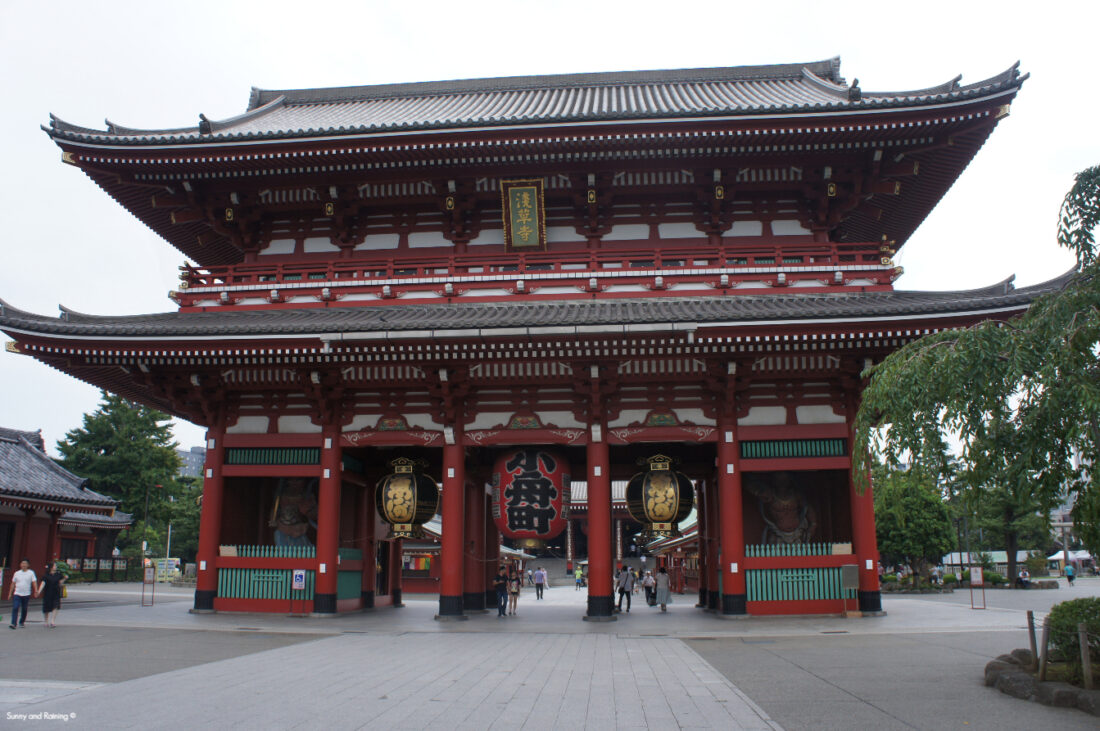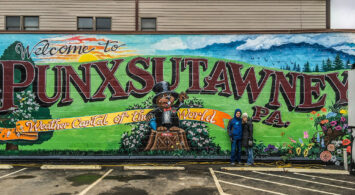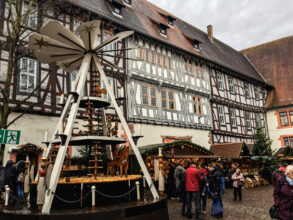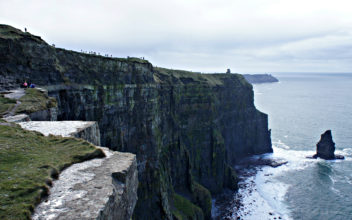T: Twelve hours of flying, a trip through customs and a 45-minute subway ride were now in the rear view mirror. Only one thing stood between us and our hotel room for our first night in Japan:
A Samba parade.
Instead of the orderly, tidy, subdued streets we expected to see (and did later on the trip), we were met with huge crowds, sirens and entire marching bands blocking the street we needed to cross in order to reach our Asakusa hotel.
We attempted to trailblaze a path through and around the crowds, luggage and all, while only pausing for a minute or two to soak in the excitement of the parade and excited crowds. We eventually found a way around it that only cost us a few more blocks in the hot, sweaty sun.
Needless to say, it was a memorable arrival in Tokyo.
E: Japan was everything I never knew I’d love.
Our first hour in the city seemed to confirm some stereotypes of Tokyo I had in my head. Crowded. Confusing. Exhausting.
But once I realized we were in the midst of a big celebration that certainly wasn’t the norm, everything started to clear up. We checked into the hotel, and were greeted by some of the nicest people I’d ever met. In fact, everywhere we went, we encountered the most polite people.
Here we were. Two Americans without the slightest clue of how to navigate this huge metropolis of a city. And yet, these people just made it so easy to ask for directions and find our way around. We came across a man whose job was just to stand on a crosswalk just to point us in the direction of the crosswalk. As we passed, he offered us a big smile and a bow — the usual salutation or greeting in japan.
Hour by hour, Tokyo continued to surprise me. And after spending just a few days in Asia, I never expected to love it so much.
Japan turned out to be one of my favorite trips we’ve ever taken.
. . .
T: Tokyo’s metro area is nearly twice the size of New York City’s. It’s unfathomable, especially for Midwesterners like us who probably don’t even appreciate the size of NYC to begin with. Over 30 million people cram into Tokyo’s metro — an area slightly smaller than Connecticut. Its 5,200 square miles of buildings, concrete, trains, parks, temples and ramen make up one of the world’s premier cities, and this was probably our favorite major city to be in.
Indisputably, this was one of the easiest metros to navigate. Unmatched connectivity, easy-to-read signage and very helpful people everywhere.
Oh, and the toilets.
For many and various reasons we haven’t spent much time discussing it on the blog, but generally speaking Europe’s public restroom scene is an abomination. In many places, most especially anywhere a tourist might go, bathrooms tend to be dirty, smelly and dark — and of course, you often have to pay for them.
Tokyo, on the other hand, sets the bar high for public toilets. Free, spot-free, odor-free restrooms were plentiful throughout the city. In many places, especially the hotels, an electronic panel controls the flush, the various bidet devices and in some cases the heated seat — luxuries we didn’t even know we needed. Bathroom breaks on our voyages throughout Europe can be quite disruptive and unpleasant at times, but they were no problem at all in Japan.
T: The first evening of our trip we spent meandering around the streets of the Asakusa area. Every neighborhood of Tokyo is different from the next, and after making a quick trip to the Imperial Palace Gardens, we immersed ourselves in the Asakusa culture.
Asakusa, on the north side along the Sumida River, exudes a traditional Japanese vibe and surrounds the Senso-ji Temple area with many shops, storefronts and string lights. We soaked in a few of the blocks while scrounging around for ramen, then took in the temple and Asakusa Shrine, a five-story pagoda that flanks the shrine.
The dazzlingly clean and detail-oriented nature of the entire country is exemplified in the Shinto temples, some of which date back centuries. The Senso-ji Shrine, which dates back to around 645 A.D., is a beautiful exposition of the Shinto religion and is visited by millions. It was very relaxing to explore the grounds in the evening without all the tourists.
We only were able to visit a few of these shrines and gardens, which are speckled throughout Tokyo (and the rest of the country, really). But their beauty is unmistakable in contrast to the concrete jungle towering high in all directions. We meandered through a few gardens during our stay too, including the Shinjuku Gyoen gardens on our way back to the airport our last day.
. . .
E: After wandering the streets of Tokyo for a few hours after we landed, we knew we needed some fuel to keep us awake past 7 p.m.
My only experience eating Japanese food comes from eating at the Rah’mn restaurant just down the street from our old place in St. Paul. I had no idea how different it would be to traditional Japanese food, but I figured eating ramen would be a safe choice for a first meal in Asia.
We wandered into a tiny little ramen place that looked decent enough. There was a small kiosk by the front door prompting us to order, but we had absolutely no idea what we were doing. A friendly man welcomed us to take a seat at the long table inside the restaurant, and asked what we wanted to eat. Not knowing how to respond, we pointed to a picture of what we wanted. Good enough for him.
Just moments later, two bowls of steaming hot ramen were placed in front of us. The only obstacle between us and the ramen? Chopsticks. 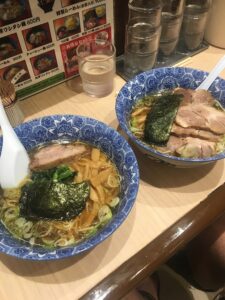
I had never successfully used chopsticks in my entire life. And I was just then realizing that every meal would likely be eaten with chopsticks.
After a few attempts, the nice man walked over and showed us the proper way to use chopsticks. I’m really not sure why I couldn’t grasp the concept, but they continued to chuckle at me as I attempted to eat.
I smiled back — a bit embarrassed. I did eventually finish the bowl of ramen, which turned out to be the best ramen of the entire trip.
. . .
E: Around 4:30 a.m. on our first morning in Tokyo, we awoke to the familiar caffeine/jetlag headache. There was no falling back asleep, and we knew we needed to find some coffee.
We spent a few minutes searching Google Maps, but it seemed we’d have to wait until 6 a.m. or so for anything to open.
But then we remembered the Denny’s we had walked past the day earlier. Turns out they’re open 24 hours just like in America. But as soon as we walked inside that Denny’s (or “Denya’s,” as their coffee mugs said) at 5 in the morning, we realized this was nothing like home.
This place was bustling. Near the front door, there was a man sleeping with his head on the table. We weren’t sure how long that full plate of food had been sitting next to him.
We were escorted to a table near the back, and we gazed at the table next to us. Another man was fast asleep with his head on the table, too. And that’s when we began to wonder: Were these people up extremely early? Or extremely late?
They were eating ramen and soup and meals that just didn’t seem all that appealing at this hour.
We decided to stick with what we knew: breakfast.
I settled on one of the more familiar-looking dishes. Luckily, most Japanese restaurants have pictures of every item on the menu. We pointed to pictures of food that looked good and hoped for the best.
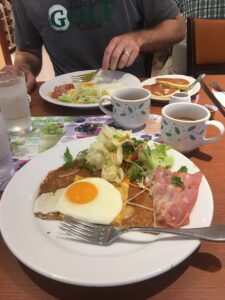 I ended up getting pancakes topped with a salad. It sounds strange, but you know — I actually quite enjoyed it.
I ended up getting pancakes topped with a salad. It sounds strange, but you know — I actually quite enjoyed it.
The waitress brought food to the sleeping man next to us and tried to wake him up. We couldn’t help but chuckle.
After making a few more trips up to the all-you-can-drink breakfast beverage bar full of coffee and juices, we decided to hit the road for the day.
We walked out of the Denny’s in Tokyo, and the man by the door was still fast asleep — his food still untouched.
. . .
T: We visited the Senso-ji Temple again, this time at 6 a.m., wandering the peaceful, empty streets and gazing at the ornate temple and nearby pagoda. There weren’t many (okay, any) big cathedrals in Tokyo, but the temples we visited were certainly an interesting change of pace.
Before long, it was time to wander to the Asakusa train station where we were to set off for Nikko (more on that later). We returned to Tokyo a few days later for one more jam-packed day in the city.
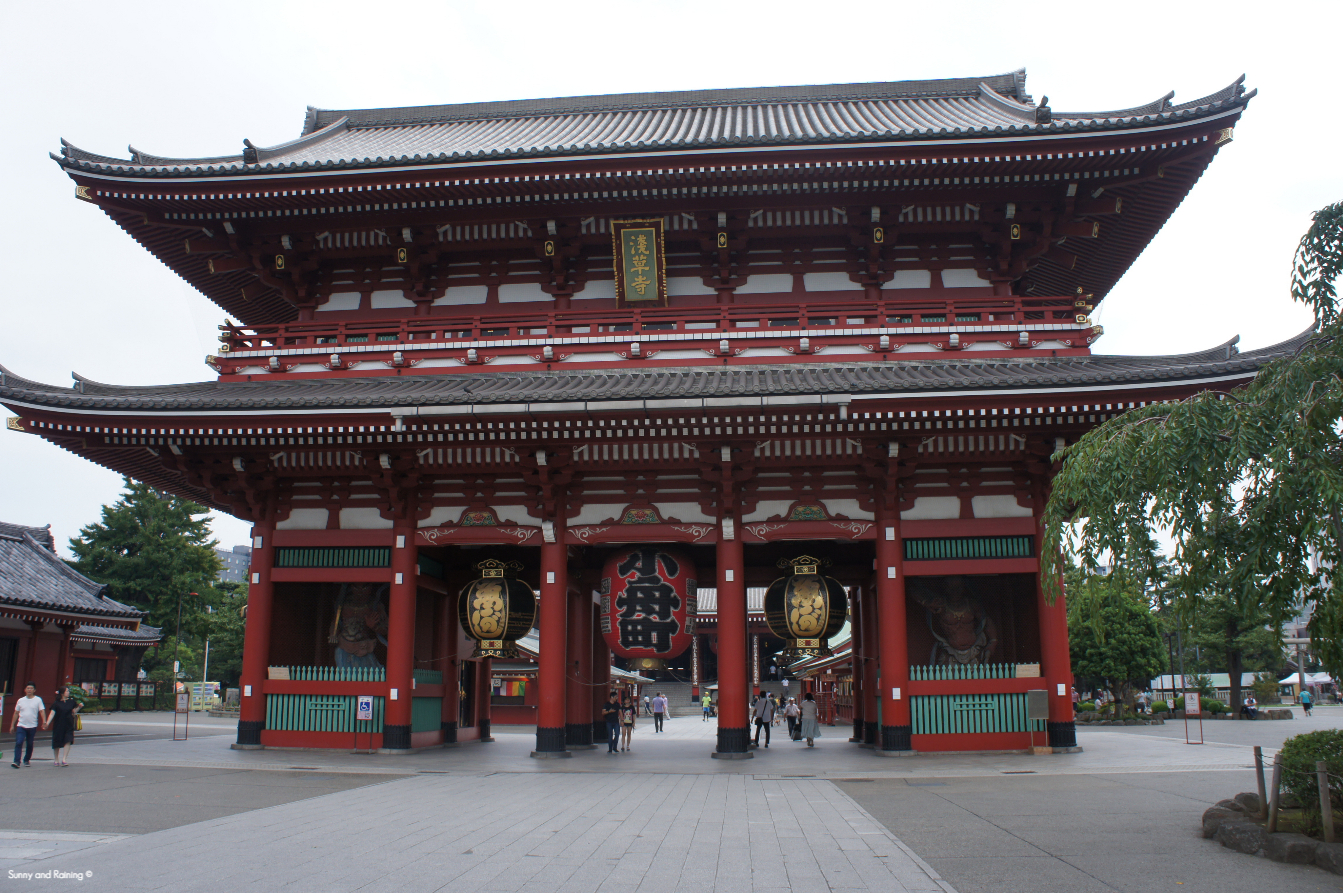
T: Our last day in Japan was spent capturing classic Japanese culture — the Olympic preparations, more ramen, tourist traps and baseball.
Upon arriving back in Tokyo, we wanted to soak in the stereotypical experience Tokyo is known for. Our hotel for our final night in Japan was north of the Shibuya ward, one of the busiest centers of all of Tokyo.
To do that, we took the subway over to Shibuya, the glitzy, neon hodgepodge of shopping malls, American fast food staples, crazy vending machines and arcades that sprawl out in all directions from Shibuya Crossing. You’ve probably seen it in movies — traffic in all directions comes to a halt, allowing thousands upon thousands of pedestrians to scramble across the streets in any and every direction, from the glistening mall to the Starbucks overlooking the crossing.
I knew I wanted to just wander, and so we did. We visited a couple of department stores — seven, nine, or 15 floor versions of their American equivalents, full of unique items and crazy English phrases on shirts such as “hamburger basketball.”
We wanted to embrace the stereotypical tourist experience to the fullest, so then we stopped at McDonalds. We were both craving ice cream (well, one of us is always craving ice cream), so we wanted to try one of the Japanese versions of the McFlurry. I nabbed a Cheesecake McFlurry — a nice refresher on a muggy Tokyo day. We had to hover a bit before we were able to grab some seats overlooking the streets, which had since emptied under a harsh summer downpour.
After returning to the streets, we found more of the same — tacky storefronts and arcades. We stopped briefly at a huge arcade with row after row of claw machine games with every animal, toy, or Harry Potter character imaginable. Fortunately, I had limited change in my pocket, so it was easy not to be tempted for too long.
. . .
E: The hotel we picked for our last night in Japan was one of the crazy coolest places we’ve ever stayed.
The Nippon Seinenkan Hotel overlooked Meiji Jingu Stadium — where we ended up watching a baseball game that evening (another post on that coming soon) — and was basically on the same block as the Olympic Stadium. The views of the baseball stadium from the lobby were incredible. We could see the entire field.
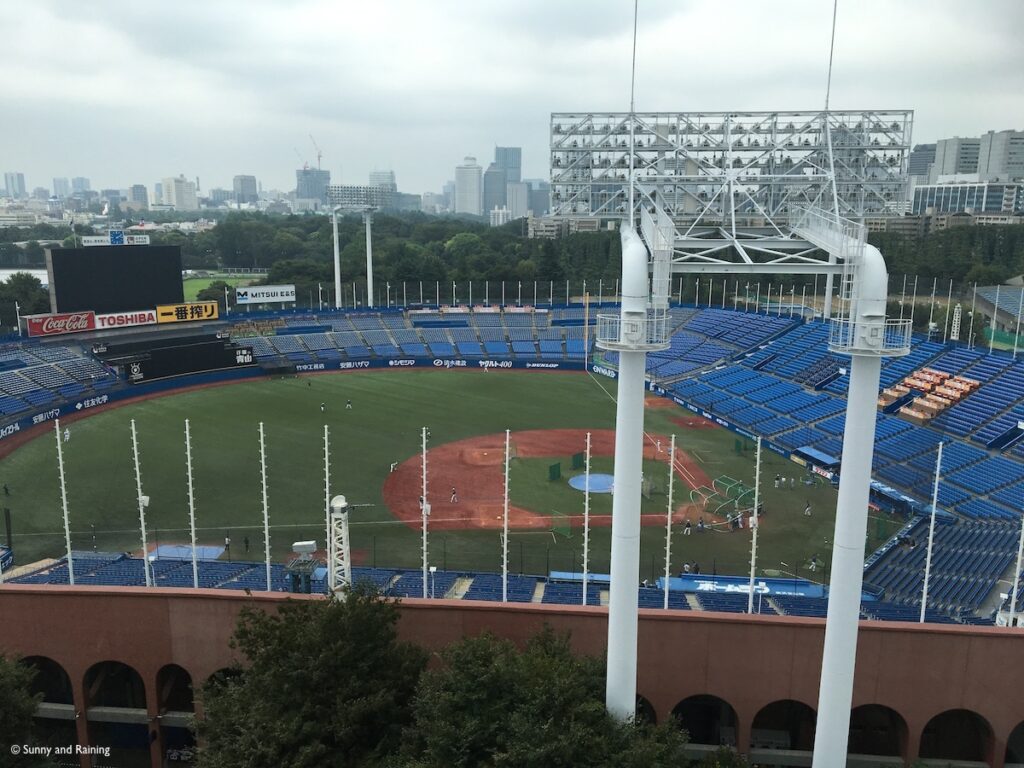 Had we not planned to be at the Tokyo Yakult Swallows game, it would have been fun to watch it from the lobby of our hotel. Though, we later found out that they close the blinds in the lobby during the baseball games — which is understandable. I’m sure the place would be packed with people wanting to watch.
Had we not planned to be at the Tokyo Yakult Swallows game, it would have been fun to watch it from the lobby of our hotel. Though, we later found out that they close the blinds in the lobby during the baseball games — which is understandable. I’m sure the place would be packed with people wanting to watch.
The Nippon Seinenkan Hotel was also the media hotel for the 1964 Tokyo Olympics, a weird little quirk that only we would find amusing. Obviously it’s been extensively renovated since then. But as media nerds, we couldn’t help but dream of someday staying in this same hotel to cover the Olympics.
We’ve seen Olympic cities and sites before in Barcelona and Salt Lake City, but it was an incredible feeling to wander the grounds of the 2020 Olympics. We had no idea at the time that they’d end up being postponed. Last-minute construction was in full swing, and we soaked it all in.
We imagined how energetic these streets would be in less than a year — how these stadiums would be filled, and visitors would bask in the excitement of the Games. The world would come together in 2020 in one of the world’s most interesting and dynamic cities.
It’s shocking how quickly that all changed.
Instead, stadiums sat nearly empty. Crowds were kept to a minimum.
We anticipated the day we would watch world-class athletes on TV competing in one of our newfound favorite cities. And when it finally happened, we celebrated with the world.
Watching the Olympics is thrilling in any city, but it was extra special this year for a lot of reasons.
Maybe it wasn’t filled with those Samba parade-like crowds this time, but it brought us all together — albeit from our own living rooms.
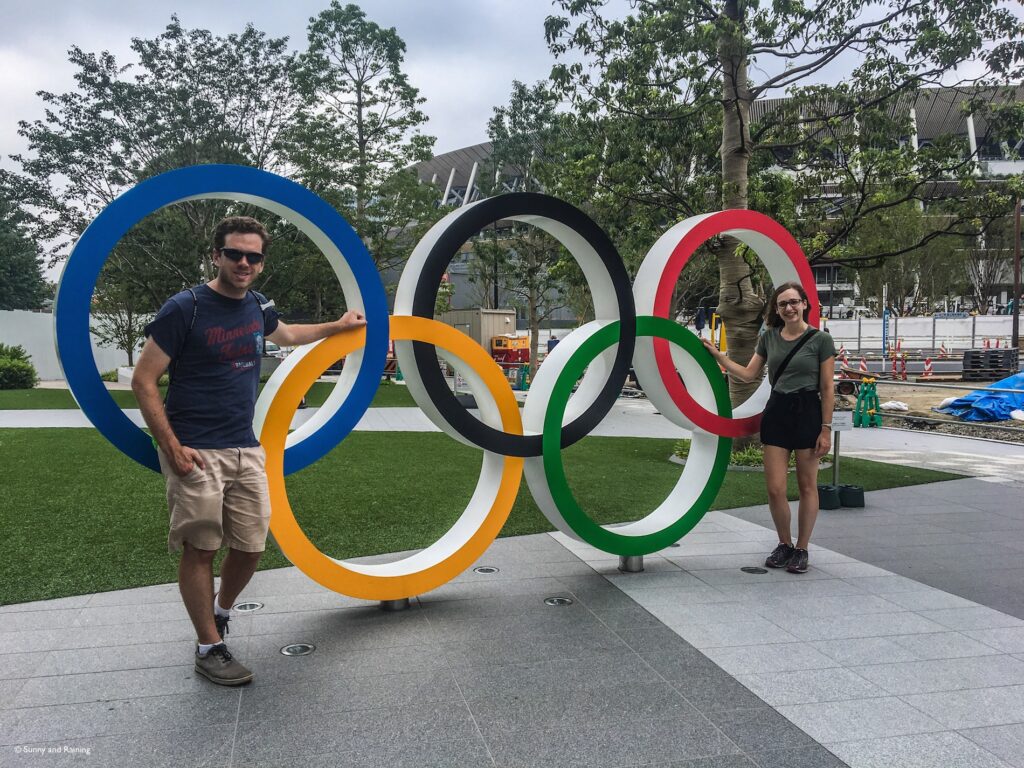 . . .
. . .
When we went: Labor Day Weekend (Early September) 2019
Where we stayed: Richmond Hotel Premier Asakusa, Nippon Seinenkan Hotel (Along with two nights in Nikko, Japan)
How long we stayed: Four nights (two in Tokyo, two in Nikko).
What we wish we knew before we went: Japan is incredibly easy to navigate — don’t stress about it.
